Characteristics and description of "Ovstuzhenka" cherry with large berries and excellent taste
The fact that the sweet cherry variety Ovstuzhenka is not widespread can only be explained by its relative youth. The variety was entered into the state register in 2001 as a promising crop for the Central region. Ostuzhenka perfectly tolerates both summer heat and frost. Suitable for cultivation in the middle lane and southern regions. Gardeners loved it for its decorative appearance, endurance and productivity.
The content of the article
Description
The variety owes its appearance to the employees of the All-Russian Research Institute of Lupinelocated in Bryansk. Biologists crossed two varieties, combining the parents' resistance to frost and excessive crown growth in a new sample.
The resulting sample is suitable for growing in the Urals and in many regions of central Russia - Kaluga, Tula, Moscow, Smolensk, Bryansk, etc.
Characteristics and description of trees
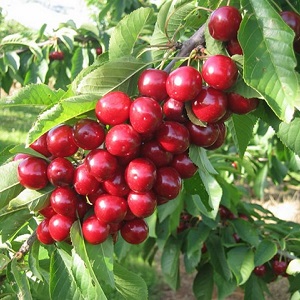 A beautiful compact crown is the hallmark of this variety.... Unlike their relatives, who require placement from each other at a distance of at least 5 m, Ovstuzhenka also tolerates a closer neighborhood.
A beautiful compact crown is the hallmark of this variety.... Unlike their relatives, who require placement from each other at a distance of at least 5 m, Ovstuzhenka also tolerates a closer neighborhood.
The culture grows quickly and, reaching 3 m, forms a spherical crown... The main skeletal branches are straight, brown, glabrous. Castings are large, egg-shaped with a sharp tip and serrations. Their surface is matte, dark green.
Flowering occurs in mid-May in trees over five years old... Despite the possibility of repeated frosts, flowering is always lush, and the harvest is abundant.
The inflorescence consists of three flowers overlapping each other. The sepals are slightly pigmented, the stigma of the pistil rises above the stamens, and the corolla is similar in shape to a saucer. Flower buds form on the bouquet branches. The tree is fruitful - from 20 to 30 kg of ripe berries are removed from one.
Resistant to temperatures
The plant tolerates summer heat well, but requires regular abundant watering.... The variety is highly resistant to low temperatures (tolerates frosts down to -45 ° C). But in order for the plant to overwinter in such conditions, it is necessary to carry out a number of preparatory measures.
Moisture and drought resistance
The tree reacts extremely negatively to the lack of moisture... Watering is carried out once a week, adding at least 30 liters of water under each tree. Like any other sweet cherry, in conditions of severe drought, the tree does not form a sufficient number of fruit buds, which directly affects the yield.
Disease and pest resistance
Wood has high resistance to diseases such as moniliosis and coccomycosis... This greatly facilitates the growing process. However, it is necessary to carry out preventive maintenance periodically, especially in seasons with unfavorable weather conditions.
The most dangerous pests for cherries are birds... The most effective way to deal with them is with nets.
Interesting on the site:
Cold and disease resistant cherry variety "Bryanskaya rozovaya"
Characteristics and description of berries
Berries near cherries Ovstuzhenka of medium size and oval shape... Their mass varies from 4 to 7 g. The color is black with a dark red tint.They have a mild sweet taste and are highly rated on a tasting scale of 4.7 out of 5.
The peel is dense, does not crack with a large amount of precipitation and retains its presentation well. The pulp is simply separated from the stone, and also has a deep red color. The juice is dark, thick, burgundy.
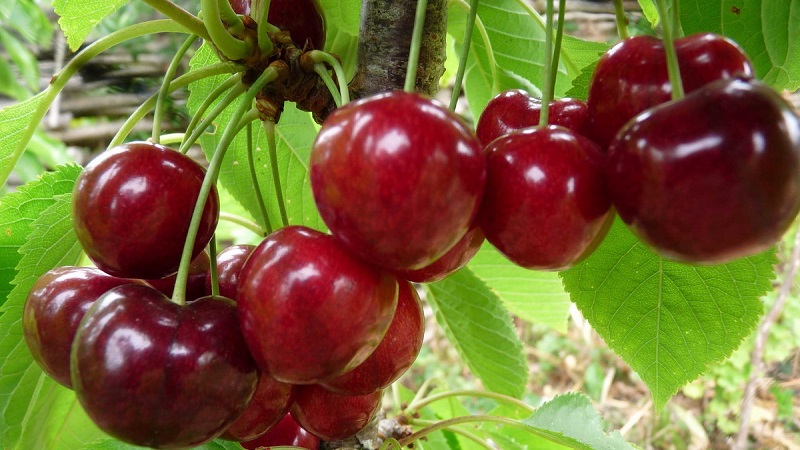
Maturation occurs in early June... When harvesting, the berries are cut off along with the stalk. This method minimizes trauma to the berries and minimizes the loss of juice. The crop easily tolerates transportation and storage for up to a week.
The fruits are used fresh, for the preparation of compotes, preserves, juices, jams, pastilles... Berries tolerate freezing well.
Important. Make sure that there are no rotten berries in the boxes, otherwise the whole batch will suffer. Remove damaged instances immediately if found.
Advantages and disadvantages of the variety
Like any garden culture, Ovstuzhenka has its advantages and disadvantages.
Positive traits:
- early fruiting;
- high productivity;
- resistance to low temperatures;
- disease resistance;
- decorative look;
- neat crown sizes.
Its main negative feature - low self-pollination and poor tolerance of low temperatures by young branches. However, with proper care organization, negative aspects can be easily minimized.
Growing technology
The optimal age for planting a young tree is two years... The place has been prepared since autumn. The seedling is bought directly on the day of planting. Signs of a quality tree are a strong root system, no rotten roots and at least two central shoots. Ideally, the seedling should be certified.

The landing technology is as follows:
- Given the compact size of the crown, the planting pit can be made not too deep. For comfortable development, 60 cm deep and 80 cm wide are enough.
- To feed the seedling, a bucket of compost mixed with humus in equal proportions is laid on the bottom in the form of a hill. Also add 200 g of any complex fertilizer.
- The seedling is placed on a hill so that the roots are straightened, and the grafting site is directed to the south and rises 4-5 cm above the soil level.
- The pit is filled up, periodically shaking the plant to remove the voids between the roots. The soil is compacted tightly. Pour two buckets of water and mulch.
- The main shoot is cut with a sharp pruner to a height of 80 cm, and the tree is tied to a hammered peg to protect it from the wind.
Terms and rules of landing
The gardener chooses the period and time of planting depending on the region of residence... In warm regions, preference is given to planting before winter, and in the central zone and in the Urals - in the spring.
It is better to plant in autumn a month before the arrival of winter and frost... This period should be enough for the seedling to take root. The spring planting period is the time before the sap begins to move, until the tree begins to show signs of activity. Most often it is mid-April. This is explained by the fact that the tree will have enough time to adapt and accumulate nutrients in order to overwinter.
With proper care, cherries can live up to 100 years., therefore, the choice of location should be taken with full responsibility. The tree loves a warm, sunny area without close groundwater. The planting hole is located on the south side of the house, fence or exposure of the hill. There should be a distance of at least 3-4 m to the nearest buildings. The soil should be loamy.
Crown formation
The volume of the crop depends on a properly formed crown., the longevity of the tree and the tendency to disease.
Basic principles:
- abduction of all branches located at an acute angle;
- removal of shoots growing inside the crown;
- an image of diseased, damaged and dry branches;
- compulsory disinfection of cut sites with garden pitch;
- the tool should be as sharp as possible.
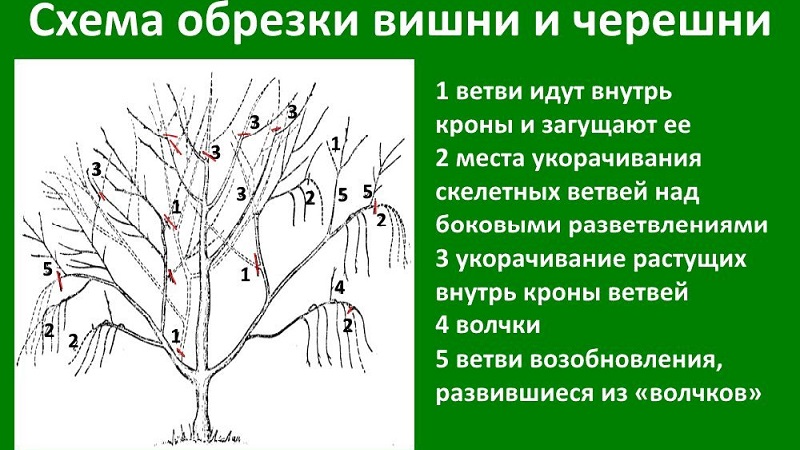
In the second year after planting, the lower tier should consist of three branches, which in the future will be the basis of the entire crown. One of them must be at least 20 cm higher than the rest. They must be shortened by a third of the length.
During pruning in the third year, the branches of the middle tier are thinned out, leaving three main... The central shoot is cut to a height of 1 m from the level of the middle tier.
In the fourth year they leave three branches of the upper tier.
Watering
The culture does not tolerate excessive moisture and acidification of the soil... Watering is most important during the period of berry formation and growth. In spring and summer, in the absence of rain, it is carried out once a week.
Water consumption depends on the age of the tree and varies from one to five buckets. After harvesting, watering is reduced to once a month. "Moisture charge" is done in October, adding up to 70 liters of water under each tree.
Important! You cannot pour water directly under the tree trunk - only into the peri-stem circle.
Top dressing
In the spring, the next year after planting, 100 g of urea is introduced into the trunk circle, evenly spreading and loosening the soil. Similarly, 400 g of superphosphate and 200 g of potassium salt are introduced in the fall.
Twice a year, all young trees are poured with a solution of mullein or any organic matter... To do this, take 1 liter of manure on a bucket of water and insist for several days. After that, another bucket of water is added and used for fertilization. The amount of fertilizer for adult plants is doubled.
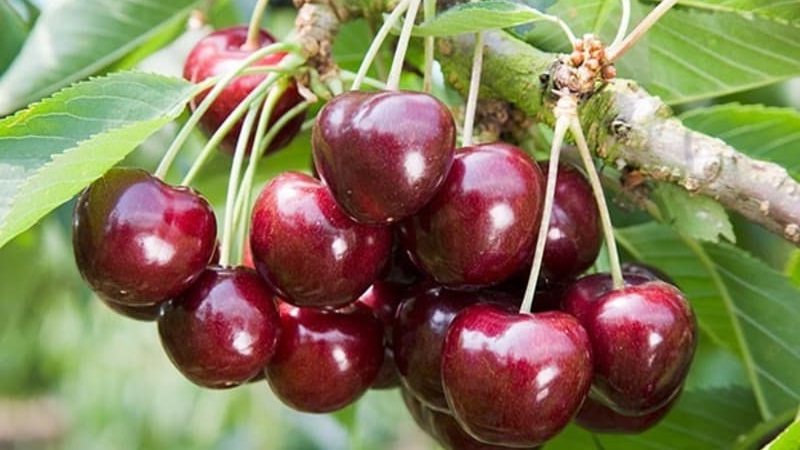
Diseases and pests
This cherry variety is not susceptible to disease... With proper care, the following general principles will be required: whitewashing the lower part of the skeletal branches and the trunk, preventive treatment in spring with a Bordeaux mixture solution and timely pruning.
The blue spray solution is prepared as follows:
- dissolve 100 g of vitriol in 1 liter of hot water in a glass jar;
- in another jar, quicklime is dissolved in the same proportions;
- after waiting for all the grains to dissolve, the white liquid is poured into a plastic bucket;
- a thin stream of blue solution is poured into whites and mixed with a plastic stick;
- filtered and poured into a sprayer.
Avoid contact with iron or other metals... Plants are treated with the resulting solution in early spring before the onset of the growing season.
If the tree is attacked by aphids, it is destroyed with the help of "Actelik"... The working solution is prepared based on the recommendations from the instructions for use.
Read also:
The best varieties of cherries for the Moscow region
Wintering
After water-charging irrigation, the soil of the circle is mulched with straw or sawdust... To preserve the integrity of the bark, whitewash is carried out. This will protect it from cracking, sunburn and pests. A solution is prepared from 1 kg of chalk, 50 g of glue and 250 g of copper sulfate. For the first five years, the plant is covered with spruce branches, non-woven material, and protective structures are erected.
Reproduction
There are several options for obtaining a new plant:
- growing from a seed, however, in this case, the berries of this seedling will have different taste and external characteristics;
- rooting of green cuttings - the method retains varietal characteristics;
- rootstock grafting is the fastest way and is used most often;
- rooting by air layers is a more reliable method than propagation by green shoots.

Features of growing this variety, depending on the region
The variety is developed specifically for the Central region, it can be grown in the Middle lane and in the Urals... In colder areas with short summers and prolonged frosts, it will be more difficult for the plant to produce crops and accumulate strength for wintering. To prevent flowering plants from being exposed to short-term frosts, they are fumigated with smoke.
Care in Siberia, the Urals and the Far East should provide the plant as much as possible nutrients.It is recommended to grow cherries on a dwarf rootstock, shelter the branches from cold winds and cut off frozen branches in a timely manner so that they do not expose the tree to infection.
Ostuzhenka is a precocious variety, so there is a risk of freezing of fruit buds during flowering... To prevent this from happening, the vegetation delay method is used. For this, the trunk circle is mulched after the first snow falls. In the middle of winter, falling snow is compacted. When it melts, the snow under the mulch will still keep the ground frozen, which delays flowering for 2-3 weeks.
Important. The Central Black Earth Region and Central Russia have favorable conditions for growing Ovstuzhenka, therefore, it does not require additional measures.
Pollinating varieties
Top pollinators: Pink pearls, Revna. If the garden is small and there is no room for plants, then you can graft a pollinator branch into the crown of the tree.
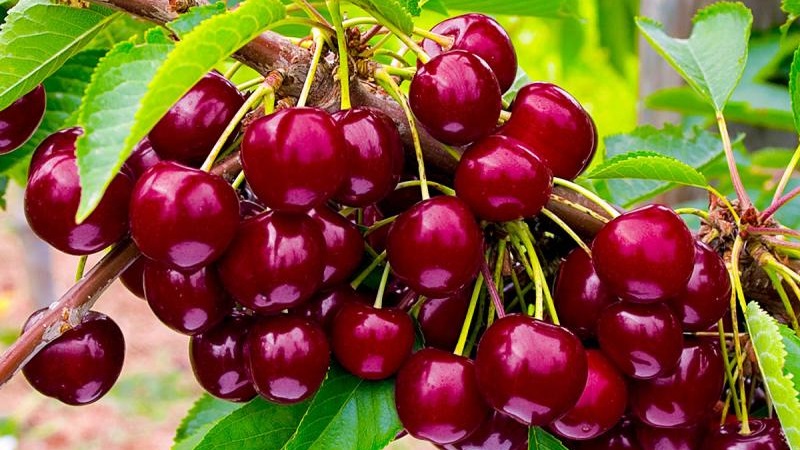
Reviews of summer residents
Reviews of summer residents from different regions of Russia are mostly positive:
Alla, Tver: “We have been growing Ovstuzhenka at our dacha for five years already. The berries are not too large, but rather sweet. The first harvest was received last year. The variety is unpretentious, but requires frequent watering ".
Valentina, Voronezh: “The whole family loves to harvest cherries. Both children and grandchildren like berries. The tree overwinters perfectly. We do not carry out special procedures for insulation. Growing since 2010 ".
Ivan, Moscow: “Despite the frosty winters, the tree produces three buckets of berries per season. Of course, birds steal a lot, but the variety is fruitful - enough for everyone. "
Conclusion
The Ovstuzhenka variety is successfully grown in almost all regions of Russia. It has an attractive appearance, is resistant to diseases and is not demanding to care for. Despite the early maturity of the variety, you can vary the onset of the growing season and enjoy delicious berries every year.